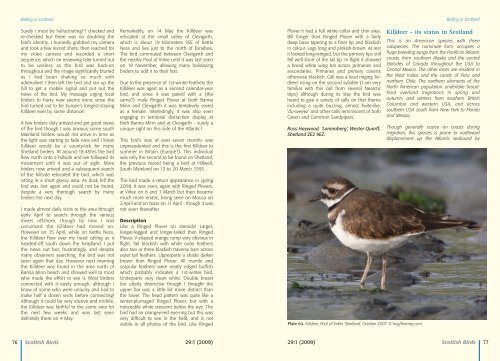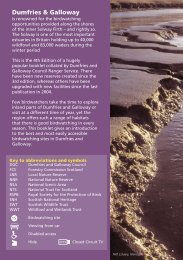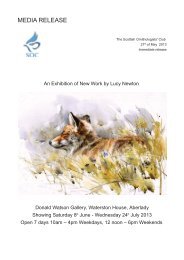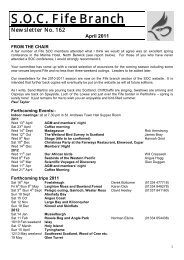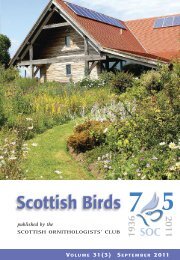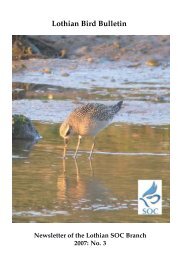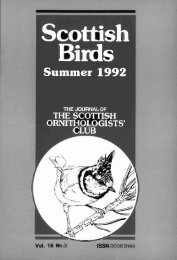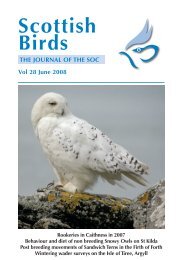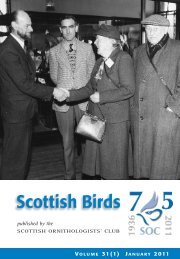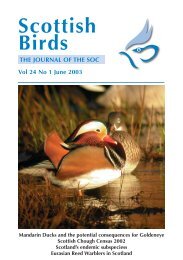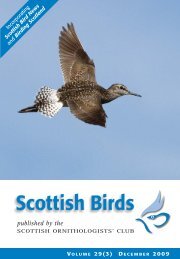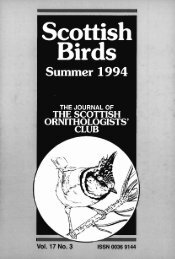*SCOTTISH BIRDS (29) TXT AW - The Scottish Ornithologists' Club
*SCOTTISH BIRDS (29) TXT AW - The Scottish Ornithologists' Club
*SCOTTISH BIRDS (29) TXT AW - The Scottish Ornithologists' Club
You also want an ePaper? Increase the reach of your titles
YUMPU automatically turns print PDFs into web optimized ePapers that Google loves.
Birding in ScotlandSurely I must be hallucinating? I checked andre-checked but there was no doubting thebird’s identity. I hurriedly grabbed my cameraand took a few record shots, then reached formy video camera and recorded a shortsequence, which on reviewing later turned outto be useless as the bird was back-onthroughout and the image significantly blurredas I had been shaking so much withadrenaline! I then left the bird and ran up thehill to get a mobile signal and put out thenews of the bird. My message urging localbirders to hurry now seems ironic since thebird turned out to be Europe’s longest-stayingKilldeer ever by some distance!A few birders duly arrived and got good viewsof the bird though I was anxious some southMainland birders would not arrive in time asthe light was starting to fade now and I knewKilldeer would be a county-tick for manyShetland birders. At around 18:45hrs the birdflew north onto a hillside and we followed itsmovement until it was out of sight. Morebirders now arrived and a subsequent searchof the hillside relocated the bird, which wassitting in a short grassy area. As dusk fell thebird was lost again and could not be found,despite a very thorough search by manybirders the next day.I made almost daily visits to the area throughearly April to search through the variousdivers offshore, though by now I wasconvinced the Killdeer had moved on.However on 15 April, while on Kettla Ness,the Killdeer flew over my head calling as itheaded-off south down the headland. I putthe news out but, frustratingly, and despitemany observers searching, the bird was notseen again that day. However next morningthe Killdeer was found in the area north ofBanna Minn beach and showed well to mostwho made the effort to see it. Most birdersconnected with it easily enough, although Iknow of some who were unlucky and had tomake half a dozen visits before connecting!Although it could be very elusive and mobile,the Killdeer was faithful to the same area forthe next few weeks and was last seendefinitely there on 4 May.Remarkably, on 14 May the Killdeer wasrelocated at the small valley of Clevigarth,which is about 19 kilometres SSE of KettlaNess and lies just to the north of Exnaboe.<strong>The</strong> bird commuted between Clevigarth andthe nearby Pool of Virkie until it was last seenon 19 November, allowing many holidayingbirders to add it to their lists.Due to the presence of 1st-winter feathers theKilldeer was aged as a second calendar-yearbird, and since it was paired with a (thesame?) male Ringed Plover at both BannaMinn and Clevigarth it was tentatively sexedas a female. Interestingly, it was also seenengaging in territorial distraction display atboth Banna Minn and at Clevigarth - surely aunique sight on this side of the Atlantic?This bird’s stay of over seven months wasunprecedented and this is the first Killdeer tosummer in Britain (Europe?). This individualwas only the second to be found on Shetland,the previous record being a bird at Hillwell,South Mainland on 13 to 20 March 1993.<strong>The</strong> bird made a return appearance in spring2008. It was seen, again with Ringed Plovers,at Virkie on 6 and 7 March but then becamemuch more erratic, being seen on Mousa on2 April and on Noss on 11 April - though it wasnot seen thereafter.DescriptionLike a Ringed Plover on steroids! Larger,longer-legged and longer-tailed than RingedPlover. V-shaped orange rump very obvious inflight. Tail blackish with white outer feathersalso two or three blackish traverse bars acrossouter tail feathers. Upperparts a shade darkerbrown than Ringed Plover. All mantle andscapular feathers were neatly edged buffishwhich probably indicates a 1st-winter bird.Underparts very clean white. Double breastbar utterly distinctive though I thought theupper bar was a little bit more distinct thanthe lower. <strong>The</strong> head pattern was quite like awinter-plumaged Ringed Plover, but with anoticeable white crescent below the eye. <strong>The</strong>bird had an orangey-red eye-ring but this wasvery difficult to see in the field, and is notvisible in all photos of the bird. Like RingedPlover it had a full white collar and chin area.Bill longer than Ringed Plover with a fairlydeep base tapering to a finer tip and blackishin colour. Legs long and pinkish-brown. At restit looked long-winged, but the primary tips stillfell well short of the tail tip. In flight it showeda broad white wing bar across primaries andsecondaries. Primaries and primary covertsotherwise blackish. Call was a loud ringing ‘kiideee’rising on the second syllable (I am veryfamiliar with this call from several Nearctictrips) although during its stay the bird washeard to give a variety of calls on that themeincluding a quite buzzing, almost Twite-like,‘du-weeez’ and other calls reminiscent of bothGreen and Common Sandpipers.Russ Haywood, ‘Lamnaberg’, Wester Quarff,Shetland ZE2 9EZ.Plate 64. Killdeer, Pool of Virkie, Shetland, October 2007 © hughharrop.com.Birding in ScotlandKilldeer - its status in ScotlandThis is an American species with threesubspecies. <strong>The</strong> nominate form occupies ahuge breeding range from the Pacific to Atlanticcoasts, from southern Alaska and the centrallatitudes of Canada throughout the USA toCentral Mexico. <strong>The</strong> other races are resident inthe West Indies and the coasts of Peru andnorthern Chile. <strong>The</strong> northern elements of theNorth American population undertake broadfrontoverland migrations in spring andautumn, and winters from southern BritishColumbia and western USA, and acrosssouthern USA south from New York to Floridaand Mexico.Though generally scarce on coasts duringmigration, this species is prone to northwarddisplacement up the Atlantic seaboard by76<strong>Scottish</strong> Birds <strong>29</strong>:1 (2009) <strong>29</strong>:1 (2009)<strong>Scottish</strong> Birds 77


